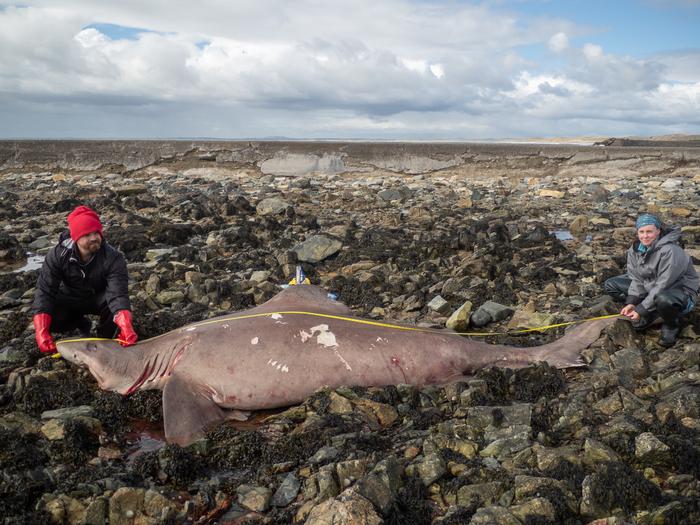Scientists believe a huge 14ft smalltooth sand tiger shark, which washed up at Kilmore Quay, Co. Wexford, earlier this year, represents the first of its species to have been found in Ireland’s waters. Two other individuals of the same species also washed up on the UK coastline, suggesting this species’ geographic range has shifted. The scientists believe these rare finds may offer a window into the future, with more and more species traditionally confined to more tropical waters expected to visit Irish and British waters.

Credit: Dr Jenny Bortoluzzi and Kevin Purves
Scientists believe a huge 14ft smalltooth sand tiger shark, which washed up at Kilmore Quay, Co. Wexford, earlier this year, represents the first of its species to have been found in Ireland’s waters. Two other individuals of the same species also washed up on the UK coastline, suggesting this species’ geographic range has shifted. The scientists believe these rare finds may offer a window into the future, with more and more species traditionally confined to more tropical waters expected to visit Irish and British waters.
Odontaspis ferox is a species rarely encountered by humans because it is normally distributed in deep water (over 100 m) offshore. In fact, while found in a number of locations in temperate and tropical seas worldwide, this species was thought to be distributed only as far north as the Bay of Biscay in the eastern Atlantic, with scientists surprised to see it so much further north.
Shark biologist Dr Nicholas Payne, an assistant professor in Trinity’s School of Natural Sciences, was notified of the stranding by a Swiss tourist who happened across the shark.
Dr Payne and the Trinity team of Dr Jenny Bortoluzzi and PhD candidate Haley Dolton were accompanied by UCD scientist Kevin Purves. Together they rushed against the incoming tide to take as many measurements and samples as possible so they could learn about the biology of this uncommon animal, and uncover clues as to why it died.
They recently reported their findings in the Journal of Fish Biology.
Dr Payne said:
“When a smalltooth washed up on the south English coast two weeks before the Irish one we all thought that was very strange at the time given the northerly location. To see a second one in Ireland so soon after was more than a little concerning.
“Subsequent analyses showed that sea bottom temperatures across the Celtic Sea and The Channel were considerably elevated in summer 2022 and remained warmer than average throughout early 2023. We therefore suggest that unseasonably warm conditions brought the individuals up from lower latitudes and into water previously outside of their thermal niche.
“Given the projections that sea temperatures around the UK and Ireland will continue to warm over the coming decades we expect to see more of this species, as well as others traditionally associated with more tropical habitats.”
Smalltooth sand tiger sharks, which pose no risk to people, are currently assessed as “vulnerable” by the International Union for the Conservation of Nature. While not specifically targeted by commercial fisheries, they may face threats such as bycatch, or from pollution. Maximum recorded size for females of this species is around 15 ft, putting the Irish specimen – which was a female – at the upper end of their size limits.
Dr Jenny Bortoluzzi helped with the dissection. She said:
“We were excited to take so many great quality samples from this particular rare specimen to build information that cumulatively boosts our knowledge of the species’ biology and ecology. It’s also wonderful that a member of the public contacted us because it shows increasing awareness, and we hope this encourages more people to get in touch in the future should they come across something similar.
“Despite gathering lots of data from the washed up sharks the likely cause of their demise remains a mystery on this occasion as their body condition was generally good, suggesting they weren’t malnourished, and there was no indication that the Irish specimen had been recently caught or injured.”
The Irish component of this work was supported by Science Foundation Ireland and the Irish Research Council, and the UK component by the Cetacean Strandings Investigation Programme, Research England, and the Natural Environment Research Council.
To learn more about shark research at Trinity College Dublin visit www.thepaynelab.com.
Journal
Journal of Fish Biology
DOI
10.1111/jfb.15529




